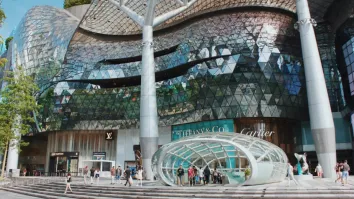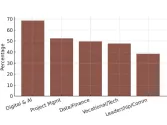State of retail in Asia Pacific in 2024 and beyond
By Nick Bradstreet and Simon Smith2024 is proving to be a challenging year for luxury across Asia. The first half of the year has seen significant sales declines for most luxury and mid-tier brands across the region. This is largely due to a slowdown in China with fewer Chinese travelling as a result of the poor economy. With residential prices falling, unemployment growing and the stock market ailing, most people in China are preferring to save their money rather than spend it. Only the super-rich have the appetite to keep spending on luxury.
Although LVMH’s (Moët Hennessy Louis Vuitton) announced a drop in net profit of 14% for the first half, the Group reported a 2% organic growth overall. However, its shares have fallen by about 20% over the past year, amidst worries that mainland Chinese middle-class shoppers are cutting back on purchases due to the property slump and job insecurity. Sales in Asia, excluding Japan which saw double-digit revenue growth, fell by 14% in the second quarter, worse than the 6% drop in the first quarter.
Kering also reported a drop of 11% in Group revenue with its recurring operating income falling by 42%. The Group shared that ‘trends in the various regions were broadly in line with the first quarter, apart from a sequential improvement in Japan and a deceleration in Asia-Pacific’.
As a result of this, brands are taking a more cautious approach to expansion with openings being pushed out beyond 2025.
The outlier is Japan which is performing strongly on the back of a cheap yen that is at a 30-year low. Price sensitive consumers are shifting their purchases to Japan rather than shopping in other destinations. This is great for stores in Tokyo but the impact is being felt in other cities where sales are down.
Real estate prices and rental trends across these markets further highlight the evolving retail landscape. Most prime retail markets had bottomed out in the first half of 2023, after four years of correction, and rents had begun to rise in the second half. Across the globe, real GDP growth in Asia Pacific remains well ahead of the US and Europe at 4.4% in 2023, followed by 2.5% and 0.5% respectively, providing a tailwind for the sector.
Meanwhile, the tourism rebound in the region has been gradual because of the delay in the easing of travel restrictions, Asia Pacific’s historical dependence on tourists from more distant markets, and a slower recovery of the important outbound market from China.
Let us look at how Asia Pacific will fare over the next few quarters: how the various markets are doing and trends that will impact the different retail sectors.
Diverse and dynamic market landscape
A diverse and dynamic landscape, the Asia Pacific retail market reflects a mix of developed and emerging economies, each with distinct consumer behaviours and retail environments. China, Japan, and Singapore are highly developed retail markets with sophisticated infrastructure and consumer bases. In contrast, markets like Thailand are rapidly evolving, driven by a combination of increasing urbanisation and rising disposable incomes.
Real estate trends
Real estate trends across the region highlight the evolving retail landscape. In Singapore, for example, prime retail spaces such as Orchard Road continue to see rising rents due to strong demand, despite challenges faced by suburban retail markets.
The average monthly rent in Orchard Road increased by 0.7% quarter-on-quarter to S$22.80 per square foot in Q1 2024, driven by the return of tourists and festive spending during the Chinese New Year.
Meanwhile, Hong Kong’s retail market is rising to new challenges and Hongkong Land is spending over $1b to renovate its Central portfolio to enhance the luxury offering and include more F&B alongside immersive art spaces.
Trends and outlook for 2025
Optimising spaces
Brands continue to shed marginal stores whilst cautiously upsizing their best ones. Single storied shops are now moving to duplexes often with a triplex façade. Despite the expense, the top luxury brands want to ensure they are a standout to their customers.
This is most evident on Canton Road in Hong Kong where there is a wall of branded luxury facades along the Harbour City side of the street. The trend is also very visible at Marina Bay Sands in Singapore, which has become the mecca for luxury in Southeast Asia. Where this has not happened yet, the key landlords are partnering with the super brands to achieve the same and as a result, a number of projects are ongoing across the region.
Repositioning brands
In recent years, the super brands have started to build salons and this trend continues. The aim is to attract their Very Important Customers (VICs) to the store and to create an exclusive lounge environment for them. These salons are located around drop off points or on upper floors within the stores, accessible via a private lift. Again, key landlords are working closely with the brands to realise this.
We have also seen auction houses rapidly expand. Christies, Sotheby’s and Philips have all increased their footprint, ensuring that they become more visible to the luxury consumer. In Hong Kong, all three houses have either recently opened or will be opening new stores in 2024.
Tourism-driven retail growth
Tourism will continue to be a significant driver of retail growth in the APAC region. Countries like Japan and Thailand, which are popular tourist destinations, will benefit from increased tourist spending. Japan, in particular, will continue to leverage its appeal as a luxury shopping destination, with record visitor spending driven by a weak yen.
High-end brands are expanding their presence in core retail areas, with several new flagship stores and showrooms opening in Tokyo. This expansion underscores the continued demand for luxury goods amongst both domestic and international shoppers.
Thailand, on the other hand, is looking forward to the completion of large-scale mixed- use projects that will attract both tourists and local shoppers. Thai government support to boost consumer spending and attract foreign investments, as well as its strategic location and appeal as a tourist destination, will play a crucial role in driving retail sales, especially in major cities and tourist hotspots.
Long-term growth prospects
For now, it looks increasingly likely that the retail sector may take a little longer to recover due to economic and geopolitical uncertainties. In the short term, the ongoing softening of China’s economy will be felt around the region, as Chinese consumers tighten their belts and curb their spending. How long China’s economy remains in the
doldrums will dictate the timing of any broader recovery in the region.
Longer term, Asia Pacific continues to offer a potent cocktail of youthful demographics, rising numbers of middle-class consumers, rapid urbanisation and a growth story like no other.


















 Advertise
Advertise







